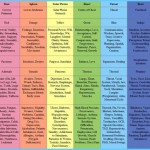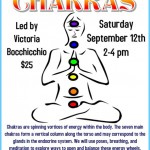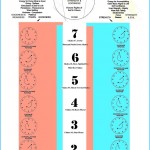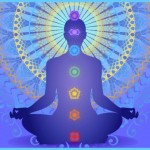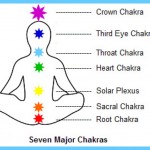Although each chakra has several colours, one colour tends to dominate.
Chakras are considered sites of life energy (‘prana’) and their main function is to draw in prana to vitalise the spiritual, mental, emotional and physical aspects of man. It is thought that man needs three sources of energy for survival – food/water, air and prana. Each chakra relates to a particular area of human experience, from our basic survival to our highest aspirations, and they interact with the body through the endocrine and nervous systems. Each one is related to an organ, a gland, and a unique area of human experience and also has an element, a mantra (sound) and a colour associated with it.
In optimum health, chakra colours are clear and transparent. They are dynamic and constantly changing, becoming cloudy and darkened by disease and other factors including accidents, trauma, drugs and negative thoughts; and becoming clearer and vitalised in response to healing modalities, positive thoughts and healthy diet. An imbalance in one chakra will have a knock-on effect on other chakras and the disharmony can eventually lead to disease in the physical body. Ayurvedic practices such as massage, yoga and meditation aim to harmonise subtle energy and prevent disease.
THE SEVEN MAJOR CHAKRAS Photo Gallery
The chakra balancing techniques in Indian Head Massage use colour and sound to promote harmony to chakra energy. As the focus of treatment is on the upper body, the three higher chakras are worked on. This is very appropriate to the modern age, as we tend to live very much on an emotional/mental level – energies involving the upper three chakras. The crown chakra is the master chakra, ruling over prana as a whole, so to promote balance here is thought to harmonise all the chakras, in turn promoting healing on all levels. The table on page 18 lists some of the emotional and physical qualities that indicate when a chakra is in or out of balance.
In Indian tradition there is much symbolism associated with each chakra to emphasise its character, such as deities, planets and elements. One important symbol is the lotus flower, which like a water lily has its roots deep in mud and darkness, but its flower blooms in the sunlight on the water’s surface, representing Indian deity with elaborate head-dress.
Balanced and imbalanced chakras man’s journey through life. Some astrologers consider that cosmic, planetary and zodiacal energies influence aspects of man via the chakras.
The chakras resemble funnel-shaped blossoms, each with a different number of petals, symbolising spokes of energy, the base chakra having the least and the crown chakra the most. The crown chakra is often referred to as ‘the thousand-petalled lotus’ and Indian art often depicts deities with elaborate headdresses, fashioned to represent a highly evolved being with a well-developed crown chakra.

